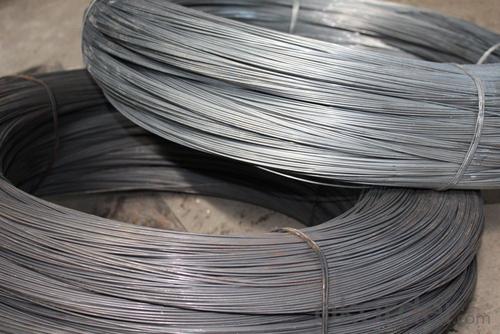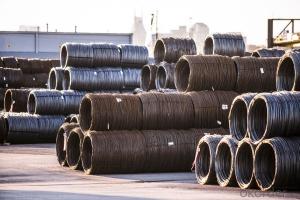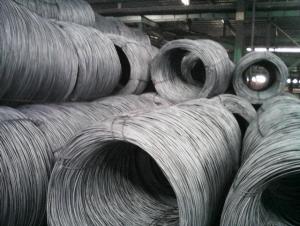SAE1006Cr Carbon Steel Wire Rod 10.5mm for Welding
- Loading Port:
- Shanghai
- Payment Terms:
- TT OR LC
- Min Order Qty:
- 100 m.t
- Supply Capability:
- 30000 m.t/month
OKorder Service Pledge
OKorder Financial Service
You Might Also Like
Specification
Description of SAE1006Cr Carbon Steel Wire Rod 10.5mm for Welding:
OKorder is offering Color Coated Steel Coil Prepainted Steel Coil at great prices with worldwide shipping. Our supplier is a world-class manufacturer of steel, with our products utilized the world over. OKorder annually supplies products to European, North American and Asian markets. We provide quotations within 24 hours of receiving an inquiry and guarantee competitive prices.

Applications of SAE1006Cr Carbon Steel Wire Rod 10.5mm for Welding:
Color Coated Steel Coil Prepainted Steel Coil are ideal for structural applications and are widely used in the construction of buildings and bridges, and the manufacturing, petrochemical, and transportation industries.
Main Product Features of SAE1006Cr Carbon Steel Wire Rod 10.5mm for Welding:
· Premium quality
· Prompt delivery & seaworthy packing (30 days after receiving deposit)
· Corrosion resistance
· Can be recycled and reused
· Mill test certification
· Professional Service
· Competitive pricing
Specifications of SAE1006Cr Carbon Steel Wire Rod 10.5mm for Welding:
PPGI:
1, Introduction: Color coated steel coils(sheets), i. E. PPGI, also called prepainted steel coils(sheets), are made of galvanized steel coils(sheets) with polymer coatings as surface. It's a new enclosure material and building board with characteristics of light-weighted, heat preserved&insulated, easily installed with bright colors.
2, Production Process: Pretreatment(Degreasing)_Drying_Chromating_Paint Basic Oil_Cooling_Drying_Color Coating_Cooling_Film-covering_Rolling Up
3, Characteristics:
Good at corrosion resistence. Besides zinc coating of the basic plate of galvanized steel sheet, the color coating as the surface has double lifetime to ensure better anticorrosion effect.
With excellent cold bending molded manufacturablity, PPGI products can be processed or directly used as final product. As being light-weighted and conveniently transported, they're widly used to replace wood to save energy.
4.There're thousands of colors can be chosen as per different application. Any color plays well in decoration.
No pollution with high recycling rate, PPGI coils and sheets are strongly recommended as enviroment-friendly products by the government.
5, eye bands and 4 circumferential bands in steel, galvanized metal fluted rings on inner and outer edges, galvanized.
| commodity | SAE1006Cr Carbon Steel Wire Rod 10.5mm for Welding |
| Techinical Standard: | JIS G3302-1998, EN10142/10137, ASTM A755 |
| grade | Q195,Q215,Q235,SAE1006,SAE1008 SAE1006Cr |
| Types: | Mesh welding |
| Base metal | galvanized, galvalume, cold rolled steel |
| Thickness | 0.14-1.0mm(0.16-0.8mm is the most advantage thickness) |
| Width | 610/724/820/914/1000/1200/1219/1220/1250mm |
| Type of coating: | PE, SMP, PVDF |
| Zinc coating | Z60-150g/m2 or AZ40-100g/m2 |
| Top painting: | 5 mic. Primer + 15 mc. R. M. P. |
| Back painting: | 5-7 mic. EP |
| Color: | According to RAL standard |
| ID coil | 508mm610mm |
| Coil weight: | 2--3MT |
| Package: | Properly packed for ocean freight exportation in 20'containers |
| Application: | Industrial panels, roofing and siding for painting/automobile |
| Price terms | FOB, CFR, CIF |
| Payment terms | 20%TT in advance+80% TT or irrevocable 80%L/C at sight |
| delivery time | 25 days after recepit of 20% TT |
| Remarks | Insurance is all risks |
| MTC 3.1 will be handed on with shipping documents | |
| We accept SGS certificatation test |

FAQ of SAE1006Cr Carbon Steel Wire Rod 10.5mm for Welding:
Q1: Why buy Materials & Equipment from OKorder.com?
A1: All products offered byOKorder.com are carefully selected from China's most reliable manufacturing enterprises. Through its ISO certifications, OKorder.com adheres to the highest standards and a commitment to supply chain safety and customer satisfaction.
Q2: How do we guarantee the quality of our products?
A2: We have established an advanced quality management system which conducts strict quality tests at every step, from raw materials to the final product. At the same time, we provide extensive follow-up service assurances as required.
Q3: How soon can we receive the product after purchase?
A3: Within three days of placing an order, we will begin production. The specific shipping date is dependent upon international and government factors, but is typically 7 to 10 workdays.
Q4: What makes stainless steel stainless?
A4: Stainless steel must contain at least 10.5 % chromium. It is this element that reacts with the oxygen in the air to form a complex chrome-oxide surface layer that is invisible but strong enough to prevent further oxygen from "staining" (rusting) the surface. Higher levels of chromium and the addition of other alloying elements such as nickel and molybdenum enhance this surface layer and improve the corrosion resistance of the stainless material.
Q5: Can stainless steel rust?
A5: Stainless does not "rust" as you think of regular steel rusting with a red oxide on the surface that flakes off. If you see red rust it is probably due to some iron particles that have contaminated the surface of the stainless steel and it is these iron particles that are rusting. Look at the source of the rusting and see if you can remove it from the surface.
- Q: What are the different types of steel wire rod testing equipment?
- There are several types of steel wire rod testing equipment that are commonly used in the industry. These include tension testing machines, hardness testers, surface defect detection devices, ultrasonic flaw detectors, and spectroscopes for chemical composition analysis. Each of these tools serves a specific purpose in ensuring the quality and performance of steel wire rods.
- Q: What are the factors that affect the pricing of steel wire rod?
- There are several factors that can affect the pricing of steel wire rod. 1. Raw material costs: One of the main factors is the price of the raw materials used to produce steel wire rod. This includes the cost of iron ore, coal, and other minerals needed in the steelmaking process. Fluctuations in these raw material prices can directly impact the pricing of steel wire rod. 2. Demand and supply: The demand for steel wire rod plays a crucial role in determining its price. When demand is high, prices tend to increase, and when demand is low, prices may decrease. Similarly, the supply of steel wire rod, influenced by factors such as global production capacity, can impact its pricing. 3. Energy costs: Steel production requires a significant amount of energy. Therefore, fluctuations in energy prices, such as the cost of electricity and fuel, can affect the overall production costs of steel wire rod and subsequently its pricing. 4. Production and labor costs: The cost of producing steel wire rod is influenced by various factors, including labor costs, machinery maintenance, transportation, and overhead expenses. These costs can vary across different regions and countries, impacting the final pricing of the product. 5. Government regulations and trade policies: Government regulations, taxes, tariffs, and trade policies can have a significant impact on the pricing of steel wire rod. Trade barriers and import/export duties imposed by governments can affect the cost of importing or exporting steel wire rod, ultimately impacting its price in the market. 6. Market competition: The level of competition in the steel wire rod market can also affect its pricing. When there are many suppliers or alternatives available, prices may be more competitive. Conversely, if there is limited competition, prices may be higher. It is important to note that these factors are interconnected and can fluctuate over time. Therefore, the pricing of steel wire rod is highly dynamic and subject to various market forces and external influences.
- Q: What are the different transportation methods for steel wire rod?
- There are several transportation methods available for steel wire rod, depending on the distance and logistics involved. Some of the common transportation methods for steel wire rod include: 1. Trucking: Steel wire rod can be transported using trucks, which is a popular and versatile method. Trucks are capable of carrying large quantities of steel wire rod and can access various locations, including remote areas. It is often used for shorter distances and is suitable for both domestic and international shipments. 2. Rail transport: Rail transport is an efficient mode for transporting steel wire rod over long distances. It offers higher capacity and can handle heavy loads of steel wire rod. Rail transport is commonly used for shipping steel wire rod from manufacturing plants to distribution centers or ports, allowing for cost-effective and reliable transportation. 3. Ocean freight: When it comes to international transportation, steel wire rod can be shipped via ocean freight. This method involves loading the steel wire rod onto cargo ships in containers or as bulk cargo. Ocean freight is suitable for long-distance transportation, especially when exporting or importing steel wire rod to different countries. 4. Air freight: Although less common due to the high cost, air freight can be utilized to transport steel wire rod when fast delivery is required. Airplanes can carry smaller quantities of steel wire rod and are often used for urgent or time-sensitive shipments. This method is particularly beneficial for international trade or when transporting to remote areas with limited road or rail access. 5. Barge transport: For areas with accessible waterways, barge transport can be an effective transportation method for steel wire rod. Barges are flat-bottomed boats designed to carry heavy cargo, including steel wire rod. This mode of transportation is commonly used for inland waterways, such as rivers and canals, providing cost-effective and environmentally friendly transport options. It is important to consider factors such as cost, distance, delivery time, and logistics requirements when selecting the appropriate transportation method for steel wire rod. Each method has its advantages and limitations, and the choice depends on the specific needs and circumstances of the shipment.
- Q: What are the different tensile testing methods for steel wire rod?
- Some common tensile testing methods for steel wire rod include the straightening and tensile testing method, the axial tensile testing method, and the wire drawing tensile testing method.
- Q: How is steel wire rod used in manufacturing?
- Steel wire rod is used in manufacturing for a variety of purposes. It is commonly used as a raw material in the production of wire products such as nails, screws, springs, and cables. Additionally, it can be used in the construction industry for reinforcing concrete structures, as well as in the automotive industry for making various components. The versatility and strength of steel wire rod make it an essential material in many manufacturing processes.
- Q: What are the main factors affecting the water consumption of steel wire rod production?
- The main factors affecting the water consumption of steel wire rod production include the type of production process used, the efficiency of water management systems, the level of water recycling and reuse, the quality of raw materials, and the overall production volume and scale. Additionally, factors such as climate, geographical location, and regulatory requirements also influence the water consumption in steel wire rod production.
- Q: How is steel wire rod used in the manufacturing of wire for aerospace applications?
- Steel wire rod is a crucial component in the manufacturing of wire for aerospace applications. The wire rod serves as the primary raw material for producing high-quality wires that are specifically designed to meet the demanding requirements of the aerospace industry. Firstly, the steel wire rod undergoes a series of processes such as cleaning, descaling, and heat treatment to enhance its mechanical properties and ensure its purity. These processes help in removing any impurities or contaminants that may affect the wire's performance or structural integrity. Once the steel wire rod is prepared, it is then drawn through a series of dies to reduce its diameter and increase its length. This drawing process is performed multiple times to achieve the desired wire thickness and strength. The wire is carefully monitored during this process to maintain its dimensional accuracy and ensure consistent quality. After the wire has been drawn to the required size, it undergoes further treatments such as annealing or stress relieving to improve its ductility and resistance to fatigue. These treatments are essential in aerospace applications where the wire will be subjected to extreme forces and temperature variations. The manufactured wire is then subjected to rigorous testing and quality control measures to ensure it meets the stringent standards set by the aerospace industry. These tests include checking the wire's mechanical properties, surface finish, and dimensional accuracy. Once the wire passes all the necessary tests, it is ready to be used in various aerospace applications. Steel wire manufactured from wire rod is commonly used in aircraft control cables, wiring harnesses, fasteners, springs, and other critical components. The wire's high strength, durability, and resistance to corrosion make it suitable for withstanding the demanding conditions of aerospace environments. In summary, steel wire rod plays a vital role in the manufacturing of wire for aerospace applications. It undergoes various processes to enhance its properties, undergoes drawing and treatment processes to achieve the desired wire dimensions and strength, and is thoroughly tested to ensure it meets aerospace standards. The resulting wire is then used in critical aerospace components, contributing to the overall safety and performance of aerospace systems.
- Q: What are the different shapes available for steel wire rod?
- There are various shapes available for steel wire rods, including round, square, hexagonal, and flat.
- Q: What are the different types of steel wire rod surface cleaning methods for wire galvanizing?
- There are several different types of steel wire rod surface cleaning methods for wire galvanizing. These include mechanical cleaning methods such as brushing or shot blasting, chemical cleaning methods such as pickling or acid cleaning, and electrolytic cleaning methods. Each method has its advantages and is chosen based on the specific requirements and conditions of the galvanizing process.
- Q: What are the common applications of low alloy and oil tempered steel wire rod?
- Various industries commonly utilize low alloy and oil tempered steel wire rod due to its wide range of applications. One such application is found in the manufacturing of automotive components. These steel wire rods are essential for producing springs, including suspension springs and valve springs, which play a crucial role in ensuring the proper functioning of vehicles. Their exceptional strength and durability make them well-suited for enduring the demanding conditions and heavy loads experienced by automobiles. Additionally, the construction industry relies on low alloy and oil tempered steel wire rod for a multitude of purposes. Reinforcing bars, also known as rebars, are fabricated from these steel wire rods and are indispensable for reinforcing concrete structures such as buildings, bridges, and highways. The strength and ductility of these steel wire rods guarantee that the reinforced structures can withstand the stresses and pressures they encounter, thereby providing stability and longevity. Moreover, low alloy and oil tempered steel wire rod finds extensive application in the manufacturing of various industrial equipment and machinery. Wire ropes, commonly used in cranes, elevators, and other lifting equipment, are frequently made from these steel wire rods. Their high tensile strength and resistance to corrosion make them suitable for withstanding heavy loads and harsh environments. Furthermore, low alloy and oil tempered steel wire rod is also utilized in the production of wire mesh, fencing, and other wire products. The strength and durability of these steel wire rods ensure that the wire products can endure external forces and provide security or containment in diverse settings, such as construction sites, agricultural fields, and industrial facilities. Overall, low alloy and oil tempered steel wire rod is widely employed in the automotive, construction, industrial, and wire product sectors. Its unique properties, including high strength, durability, and resistance to corrosion, make it a versatile material that contributes to the functionality and reliability of various products and structures.
Send your message to us
SAE1006Cr Carbon Steel Wire Rod 10.5mm for Welding
- Loading Port:
- Shanghai
- Payment Terms:
- TT OR LC
- Min Order Qty:
- 100 m.t
- Supply Capability:
- 30000 m.t/month
OKorder Service Pledge
OKorder Financial Service
Similar products
Hot products
Hot Searches
Related keywords
































